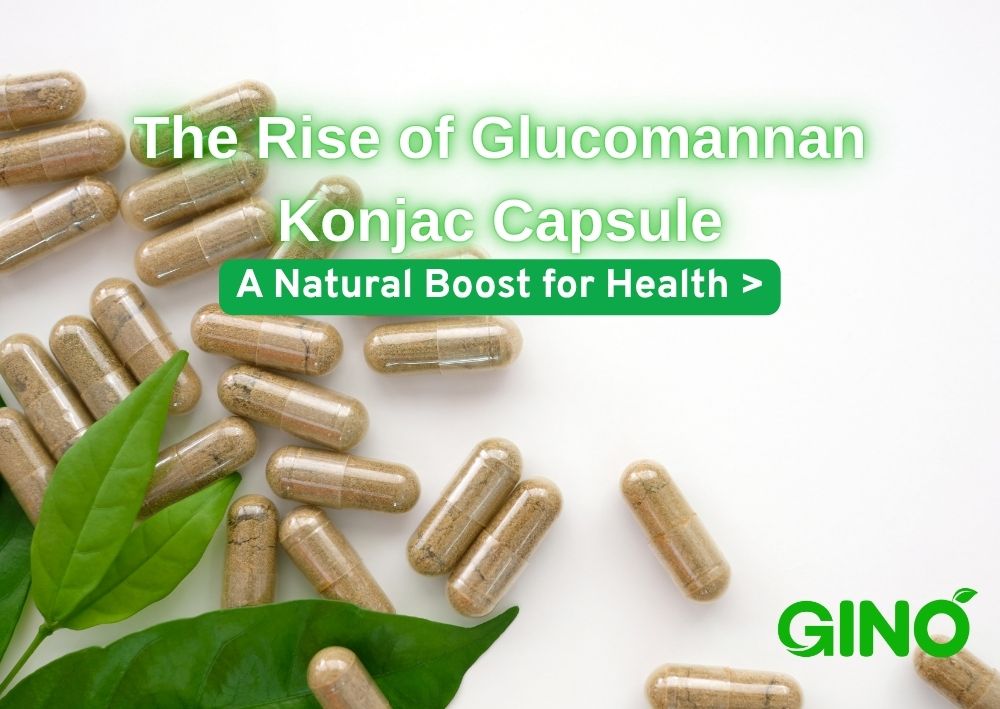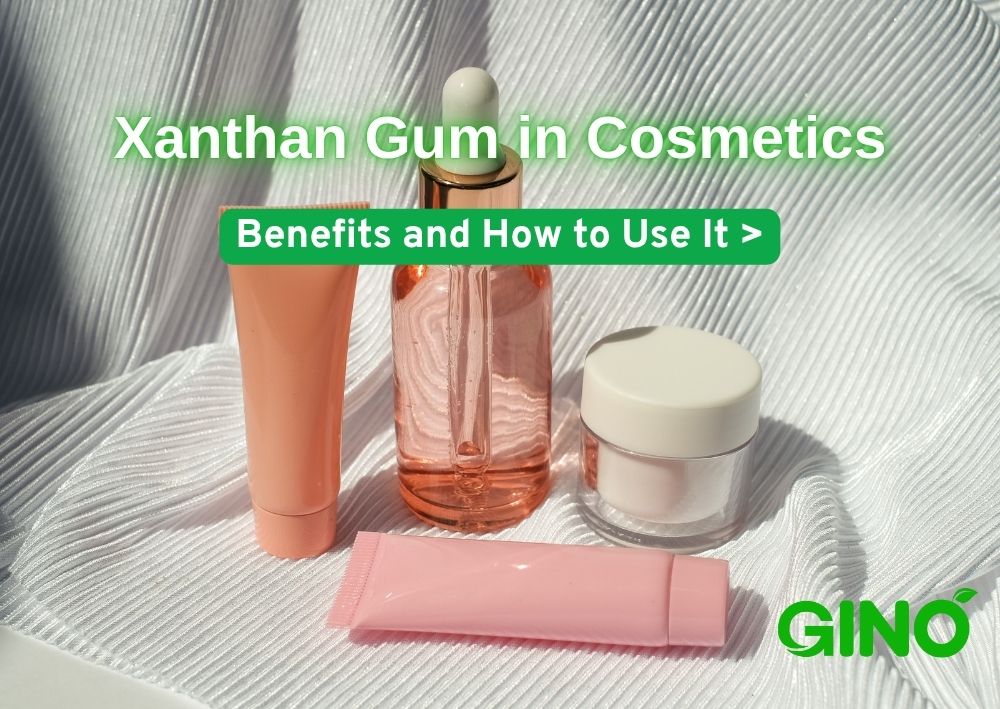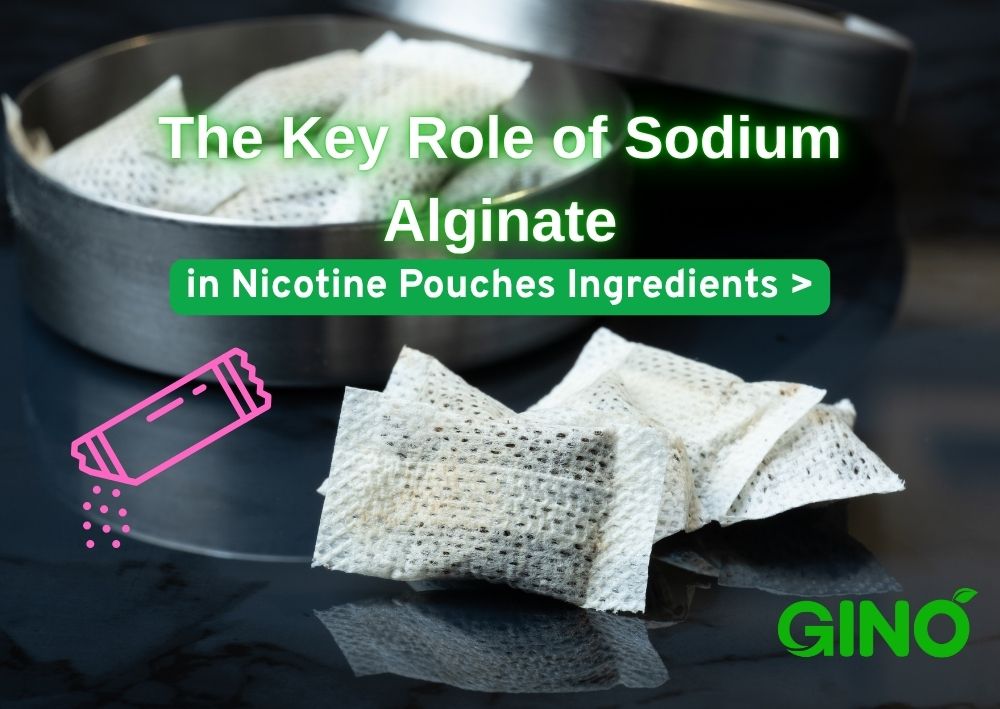
The Ultimate Guide to Suspending Agents:
6 Common Suspending Agents List, Technology Problems and Solutions
The Ultimate Guide to Suspending Agents
The biggest advantage of suspension drinks is their authenticity! Let's talk about the commonly used suspending agents list, common process problems, and solutions.
As a unique beverage variety, suspending fruit juice has been introduced for more than 20 years since the 1980s. The suspension-type fruit beverage has many excellent sensory effects and characteristics, such as a strong realistic feeling, unique appearance, rich in nutrients, ease to drink, etc., so it is favored by the majority of consumers.
The discovery of the principle of "only gel can be suspended" not only provides a reasonable explanation for the phenomenon of suspension of fruit grains but also points out the direction for the selection of suspending agents in suspended beverages: theoretically speaking, all monomer or compound gums that can produce gel can be used as suspending agents. The colloid that only produces viscosity and does not form a gel cannot be a suspending agent alone.
However, in actual production, the colloids that can really be used as suspending agents in production must also have the following characteristics:
- meet the safety requirements of food additives.
- have very good flavor release properties and excellent taste.
- with superior resistance to acid thermal decomposition.
- strong resistance to water precipitation.
- has a high gel temperature point, which is convenient for process operation.
- less dosage, with good economic performance.
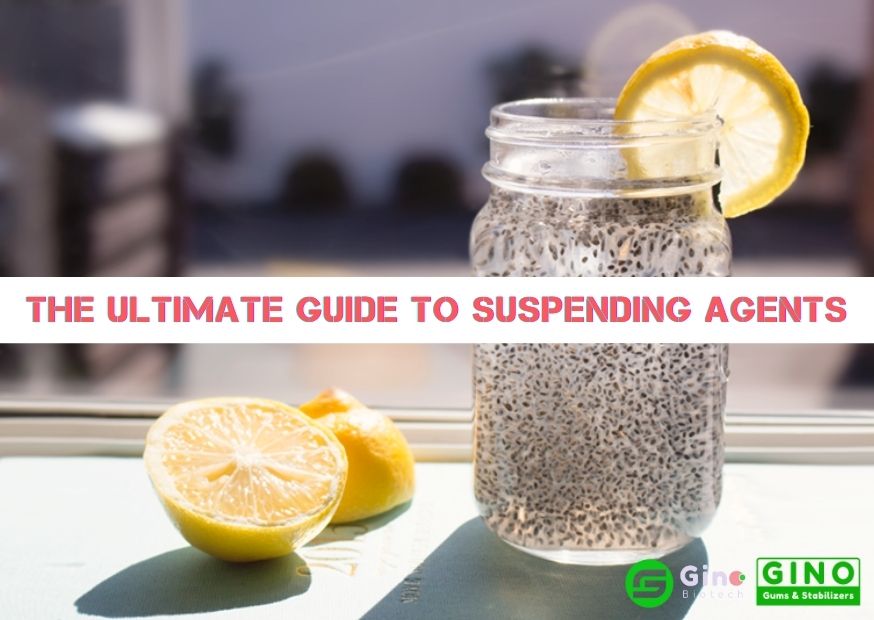
1.Introduction to the Properties and Applications of Several Commonly Used Suspending Agents Lists
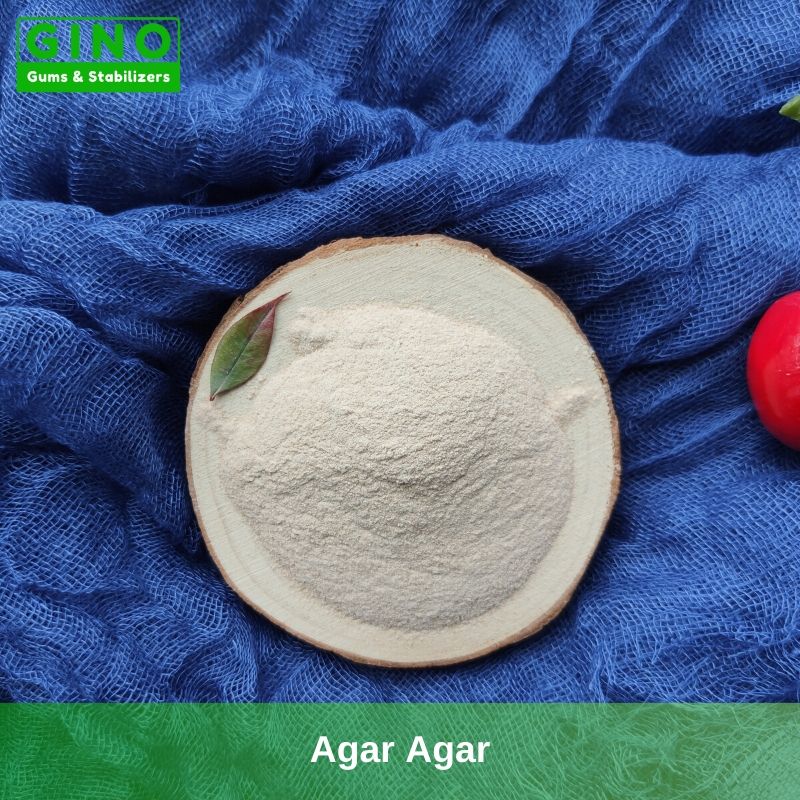
Agar was first reported as a suspending agent for suspended fruit drinks.
Ying Zhou first introduced the use of agar for the production of citrus fruit suspension drinks. Fang Xiugui and others experimented with the effect of pectin, gelatin, agar, ginkgo gum, sodium alginate, carboxymethyl cellulose (CMC), and other colloids on the suspension of citrus juice cells, and concluded that agar is the most suitable suspending agent, the use of concentration of 0.18% to 0.20%, in the presence of an appropriate concentration of ginkgo gum, the suspension effect is better.
Li Zhengming also studied the use of agar for suspended citrus juice cells and concluded that the combination of agar plus citrate could achieve satisfactory results.
The best results of agar for citrus juice cell suspension experiments were: 0.25% agar dosage, pH 3.6-4.0 of the beverage, and not too long heating time after mixing.
Zhu Makuhan concluded that agar is the strongest gelling agent among the thickeners used in current production, and the gelling effect was evident even at 0.04% concentration, and the beverage had good transparency and smooth taste.
Hu Guohua used agar in basil seed suspension drinks and pointed out that the main factors affecting agar suspension are concentration, temperature, pH, and electrolytes. High temperature and prolonged duration of high temperature and strong acidity of the solution can cause agar degradation and failure.
The gel strength and viscosity of agar are low in solutions with low pH and increase with increasing pH, with maximum viscosity at pH 6-11. The gel strength and viscosity of agar solution decreased with the increase of high-temperature duration, and after the high-temperature duration exceeded 5h, the solution viscosity was very small and could not form gelling.
Therefore, the strict control of process temperature and high-temperature duration, and the selection of suitable acidifiers and pH are the keys to the success or failure of agar suspension.
At the same time, the addition of CMC also has a great influence on the gel strength and fluidity of agar. The beverage with Agar-CMC as the main suspending agent has relatively good fluidity and stability, is transparent, and not easy to precipitate gel, showing a good combination of synergistic properties. Numerous studies have also demonstrated that Agar-CMC is an excellent suspending agent combination, resulting in clear and transparent products with good stability.
Dong Mingming et al. used agar in combination with Dianthus polysaccharide gum to produce a satisfactory aloe vera suspension drink with a suspension formulation of 0.05% agar, 0.03% Dianthus polysaccharide gum, and 0.03% potassium chloride.
Wang Yanzhe et al. used a suspension formulation of agar 0.20%, CMC 0.20%, and gelatin 0.10% to achieve good suspension stabilization of a beverage containing 7% chrysanthemum petals.

The suspension effect of carrageenan was studied by Hu Guohua et al.
The suspension effect of Carrageenan-K+, Carrageenan- Locust bean gum-K+ and Carrageenan- Konjac gum-K+ was the most ideal, and the latter two showed good combination synergism. κ-carrageenan showed a significant increase in gel strength when it was combined with konjac gum and locust bean gum respectively in a certain concentration range. ι-carrageenan also had a more ideal suspension effect, but its current market price is high and its application as a suspension agent will be limited.
Basil seed beverage with κ-carrageenan as the main suspending agent can show a good suspending effect when adding an appropriate concentration of K+ and compounding with other colloids, but its main drawback is that it is not very resistant to acid and high temperature, which affects the suspending stability of the beverage to some extent, but it is still a more ideal suspending agent for Basil seed beverage.
The amount of carrageenan used in suspended beverages is 0.1%~0.4%, K+ is 0.2% and Ca2+ is 0.2%.
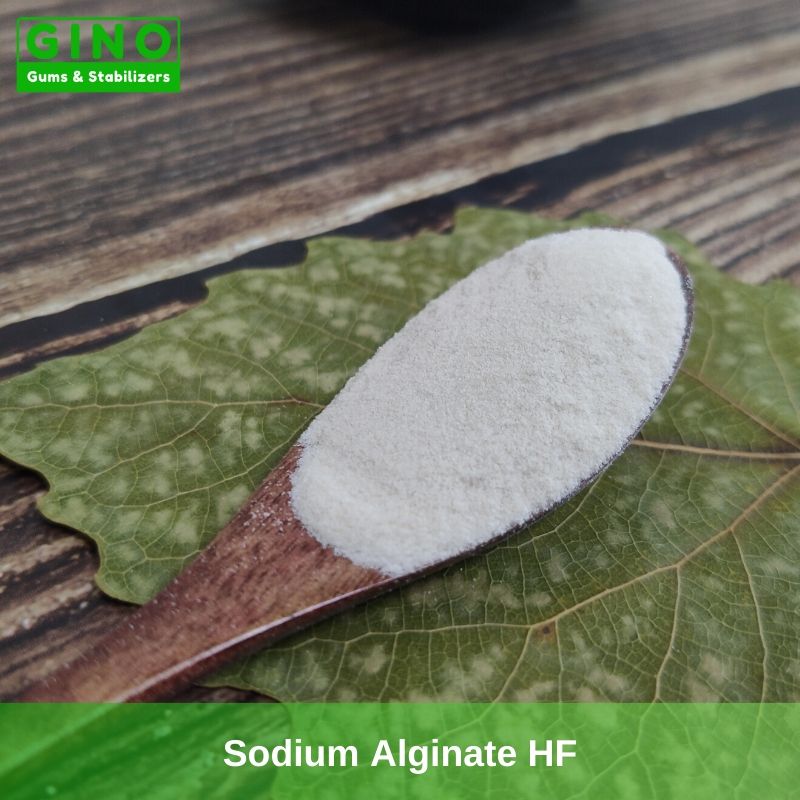
Yunfeng Xiang used a combination of 0.25% sodium alginate and 0.02% calcium chloride to produce a qualified suspended fruit capsule beverage.
Ai Zhilu is of the opinion that the suspension stabilization effect of pure sodium alginate on juice cells is not very satisfactory, and the mixture of several colloids, such as sodium alginate with carboxymethyl cellulose or gelatin, is more effective.
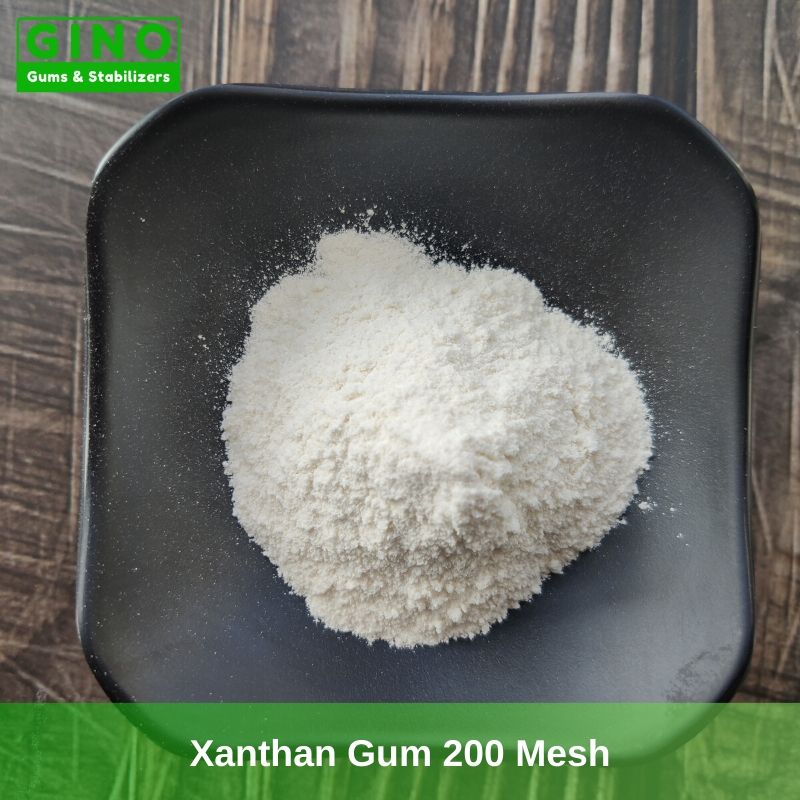
Xanthan gum has a significant feature, namely its role in promoting mannans, such as locust bean gum, guar gum, etc.
When xanthan gum is mixed with mannans, the viscosity of the mixture increases significantly compared to either of them alone.
This property allows the compound of xanthan gum and mannans to be used as a suspending agent for fruit drinks.
The synergistic effect of xanthan gum and mannans has been widely used in the suspended beverage, mainly xanthan gum + konjac gum and xanthan gum + locust bean gum two kinds of combinations.
1.4.1 Xanthan Gum + Konjac Gum
The main component of konjac gum is glucomannan, the molecular formula is [C6H10O5]n, which is a heteropolysaccharide from D-glucose and D-mannose at a 1:1.6 molar ratio to β-1,4 glycosidic bonding.
Both xanthan gum and konjac gum are non-gelling polysaccharides, but mixing them in a certain ratio can appear synergistic to obtain gels, and the synergistic effect reaches its maximum when the mass ratio of xanthan gum to konjac gum is 7:3 and the total content is 1.0%. The coagulation ability of mixed polysaccharide gels was not only related to the mixing ratio, but also to the salt ion concentration in the beverage system, and the gel strength was maximum when the salt ion concentration was 0.2 mol/L.
Dong Mingming et al. used sweet corn as raw material, using a variety of suspension agents to comprehensive study the stability of suspension drinks, the results show that the combination of xanthan gum, konjac gum, and cyclodextrin has the best suspension effect, and its optimal amount of is 0.04%, 0.02%, 0.02%. It can maximize the stability of the sweet corn grain spoon and solve the phenomenon of particle sinking during the sale and storage of the product.
1.4.2 Xanthan Gum + Locust Bean Gum
Locust bean gum is a plant seed gum produced from the seeds of the acacia tree in the Mediterranean Sea. It is a polysaccharide compound with galactose and mannose residues as structural units and does not gel on its own.
According to the study of Fan Jianping et al: xanthan gum and locust bean gum form a gel when the mixture content reaches 0.5%~0.6%. When the ratio of locust bean gum to xanthan gum was 2:8, the viscosity of the mixture was the highest and its synergistic properties were the best. When the mixture content reached 1%, the viscosity of the mixed solution of locust bean gum and xanthan gum was about 150 times higher than the viscosity of locust bean gum alone and about 3 times higher than the viscosity of xanthan gum alone. The viscosity of the mixed solution increased with the increase of the content, and the increase was small when the content was less than 0.3%; when the content was higher, there was a large increase; when the content reached 1%, the viscosity was 4370 mPa.s.
The conclusion of Guo Shoujun's study showed that
- The viscosity of the compounded gum of locust bean gum and xanthan gum increased with the increase of colloid content.
- The viscosity of the solution decreases with the increase of shear force; the compound gum is a "non-Newtonian fluid".
- Heating can increase the viscosity of the compounding gel, whereas heating for 60 min can make the viscosity of the compounding gel tend to the maximum, and heating for more than 90 min makes the viscosity decrease.
- pH has a certain influence on the viscosity of the compound gum, among which the viscosity decreases more under alkaline conditions.
- The freeze-thaw changes caused a large increase in the viscosity of the compound gum of locust bean gum and xanthan gum.
Lin Meijuan did a study on the suspension stability of glutinous corn juice with colloids and pointed out that when the mass ratio of xanthan gum to locust bean gum was 1:4, the beverage reached the lowest value of sedimentation rate and the best suspension stability.
Si Weili studied the effect of konjac gum, locust bean gum, and xanthan gum on the stability of suspension of fruit juice drinks, the results showed that when konjac gum, locust bean gum, and xanthan gum to 3:2:2 ratio, the amount of 0.06%, the stability of suspension of fruit juice drinks is the best, and moderate viscosity, no obvious gelation phenomenon.
Si Weili also studied the compounding of konjac gum, locust bean gum, and xanthan gum and the effect of various phosphates on the stability of suspended fruit yogurt drinks, the study concluded that when konjac gum, locust bean gum, and xanthan gum in the ratio of 4:1:2 by mass, and its addition of 0.06%, the system suspension is better; adding 0.08% of sodium hexametaphosphate of the total beverage, the system suspension is the best.
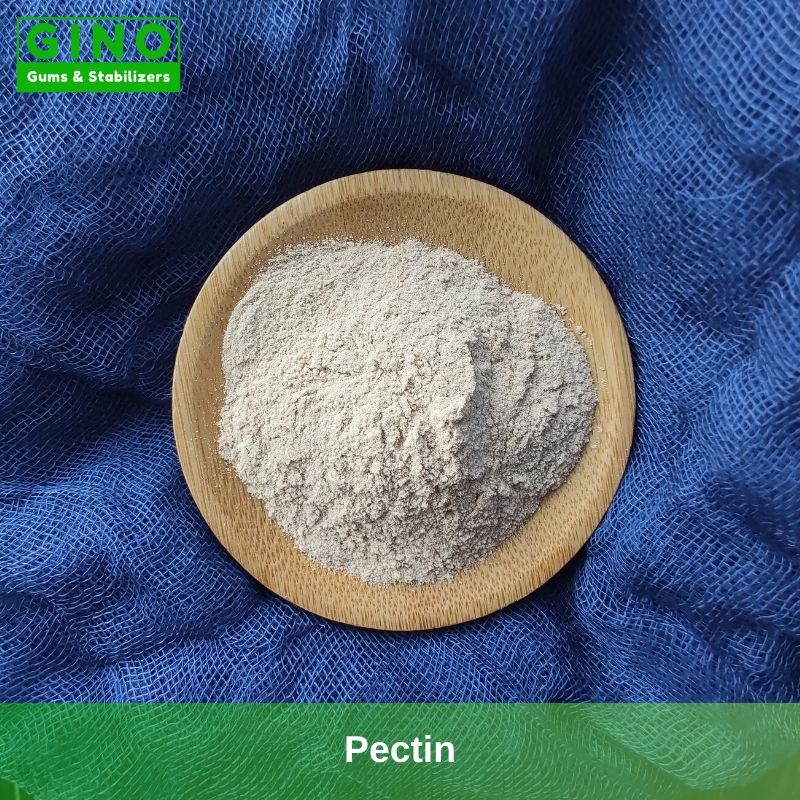
Pectin is a plant gum extracted from citrus fruit peel, etc. It is a high molecular polysaccharide with polygalacturonic acid as its basic backbone.
According to the degree of esterification of the carboxyl group on the galacturonic acid in the molecule, it is divided into high-ester (HMP) pectin (esterification >50%) and low-ester (LMP) pectin (esterification <50%).
HMP pectin forms gels by hydrogen bonding with sugars and acids, which requires high sugar concentration and is therefore difficult to be used in suspended beverages. LMP pectin, on the other hand, forms ion-bonded gels by relying on free carboxyl groups and multivalent cations and thus requires only a certain concentration of cations and certain temperature conditions to form gels with little or no sugar.
LMP pectin is a polysaccharide that is stable to acidity and has maximum gel strength and viscosity at a pH of around 3.1. Therefore, when using LM pectin as a stabilizer, the pH should be adjusted as low as possible without affecting the taste of the suspended beverage.
The advantages of LMP pectin for suspension drinks are its bright and smooth taste, as well as strong acid resistance, which makes it suitable for use in acidic drinks.
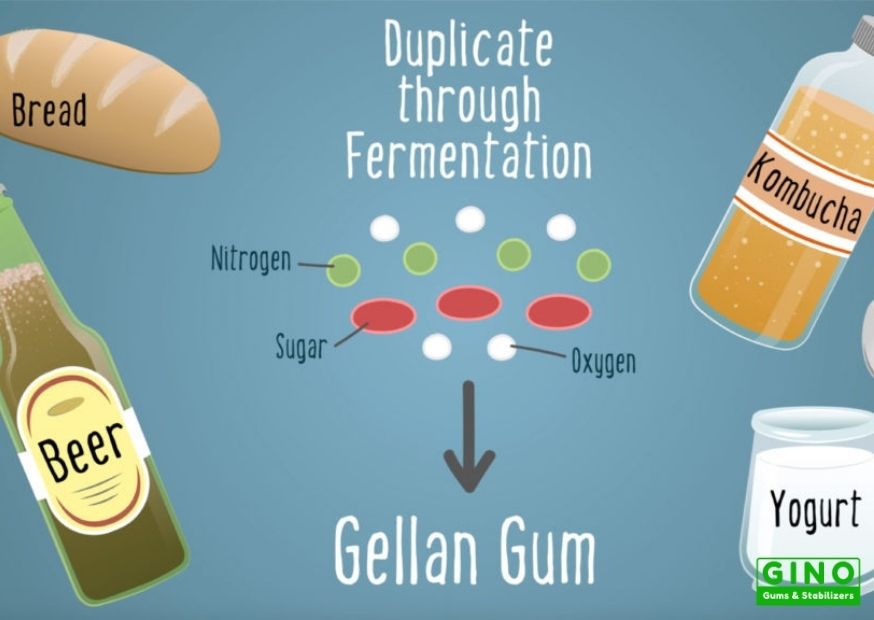
The main chain structure of gellan gum is a linear tetrasaccharide repeating unit, consisting of β-D-glucose, β-D-glucuronide, and α-L-rhamnose as repeating units polymerized in a 2:1:1 molar ratio to form a long chain molecule.
The relative molecular mass is about 0.5×106 Dalton.
The difference between high acyl gellan gum and low acyl gellan gum is that
The high acyl gellan gum has a glycerol ester group at the C-3 position of the first glucose group and an acetyl group at the C-6 position, where the glucuronic acid can be neutralized by K+, Ca2+, Na+, and Mg2+ to form a mixed salt.
Treatment of high acyl gellan gum with alkali at pH 10 gives low acyl gellan gum, which forms a brittle gel similar to agar.
The free group of low acyl gellan gum can form a gel with divalent metal ions, and according to this property, it can form a three-dimensional network structure by combining with an appropriate amount of Ca2+, Mg2+, and other ions.
It has good support force, pseudo-plasticity, and low viscosity, so the beverage can maintain good flow and suspension ability, and it is also stable under acidic conditions, so it has good application value in fruit suspension beverages.
Zhu Shubin prepared the suspension solution with low acyl gellan gum, calcium carbonate, sodium polyphosphate, and citric acid as single factors, and the best formulation of the suspension system with low acyl gellan gum was obtained by orthogonal test.
Low-acyl gellan gum 0.018%, calcium carbonate 0.04%, sodium polyphosphate 0.02%, citric acid 0.2%.
The suspension system was transparent and the fruit particles remained uniformly suspended for 90 days.
Zhong Fang et al. concluded that rheologically, the gellan gum sol with 0.1% to 0.4% showed typical yield pseudoelasticity. The yield stress of 0.1% gellan gum sol was 0.405 Pa, which was higher than the shear stress formed by the sinking of orange sand capsules under the effect of gravity. Therefore, gellan gum has the potential to be used as a suspending stabilizer in fruit-suspension beverages.
The results of accelerated storage experiments showed that orange sand capsules were best suspended when the gellan gum content was 0.08% and the Ca2+ ion content was 160 μg/g.
On this basis, we analyzed the compounding of gellan gum with xanthan gum.
With the gel network structure formed by gellan gum and the increase of continuous phase viscosity of xanthan gum under the action of shear force, the sinking distance of orange pulp was less than 1.5 cm at 90 days of resting in the accelerated experiment of orange pulp suspended beverage.
The use of compound gum also facilitated the retention of orange flavor, with 28.7% retention of limonene after 25 days of accelerated storage, compared to 0.08% retention of the control sample without gum.
Wang Xiumei's study concluded that 0.025% gellan gum could play a good suspension effect when the pear particles were 3mm in diameter, and the shelf life could reach one year.
The gel of high acyl gellan gum is soft and elastic, and its gel structure is suitable for many food products. In dairy suspension, the rheology of high acyl gellan gum at low concentration can play a good role in suspension, high acyl gellan gum is widely used in the suspension of fruit pulp and cocoa powder in dairy products.
The advantages of high acyl gellan gum in yogurt are as follows
1) It is soluble in casein and does not form wall-hanging phenomena like low acyl gellan gum.
2) Low dosage and good structural recovery properties.
3) High acyl gellan gum can also be used in juice and soy beverages containing fiber without precipitation.
4) High acyl gellan gum forms a soft and elastic gel at about 72℃ without temperature hysteresis.
Because of the advantages of high acyl gellan gum such as low dosage, high gel temperature point, anti-water precipitation, and no wall hanging, it is widely used in the suspension of "fruit milk".
1.7 Comparison of Basic Properties of Several Commonly Used Suspending Agents
From the above, we summarize the main properties of several hydrocolloids suitable for suspended beverages in Table 1 and Figure 2.
Table 1 Comparison of the Suspension Properties of Several Hydrocolloids
Type | Beverage Taste | Heat and Acid Decomposition Resistance | Dosage,% | Suspension Temperature | Enhancer |
Agar | Refreshing taste, strong flavor release | Weak | 0.1-0.15 | 20-28 | CMC etc. |
Carrageenan | Viscous, weak flavor release | Weak | 0.04-0.06 | 20-35 | K+, CA2+, Mg2+, polymannose, etc. |
Xanthan gum + Konjac gum | Strong viscosity, weak flavor release | Medium | 0.03-0.05 | 25-45 | Phosphate, citrate |
Xanthan gum + Lotus bean gum | Strong viscosity, weak flavor release | Medium | 0.03-0.05 | 25-45 | Phosphate, citrate |
Sodium Alginate-High G | Strong viscosity, weak flavor release | Weak | 0.1-0.2 | / | Ca2+, buffer, etc. |
Sodium Alginate-High M | Refreshing mouthfeel, medium flavor release | Weak | 0.1-0.2 | / | Ca2+, buffer, etc. |
LM Pectin | Strong viscosity, weak flavor release | Stronger | 0.2-0.4 | 25-35 | Ca2+, Mg2+, etc. |
Low Acyl Gellan Gum | Refreshing mouthfeel, medium flavor release | Stronger | 0.01-0.02 | 25-38 | K+,Na+,Ca2+,Mg2+, etc. |
High Acyl Gellan Gum | Fresh mouthfeel, strong flavor release | Stronger | 0.01-0.02 | 55-75 | K+,Na+,Ca2+,Mg2+, etc. |
Note: / means no relevant research data are available | |||||
2. Common Process Problems and Solutions in the Production of Suspension Beverages
2.1 Acid-thermal Degradation of Suspending Agents
Acid-thermal degradation of suspending agents is a key factor affecting the stability of suspended fruit drinks.
Acid heat conditions can aggravate the decomposition failure of colloids, the most obvious ones are agar, carrageenan, and mannoproteins, only pectin, and gellan gum are slightly more resistant to acid heat.
The decomposition of colloids can seriously affect the suspension effect.
In the production practice, if the heating time of colloid is too long during the ingredient process, the acid addition time is too early, or due to the storage barrel capacity is too large, resulting in a long storage time of hot material, will cause suspension difficulties, or the same batch of products in the initial filling product and the end filling product quality inconsistent situation.
In order to solve this problem, we can adapt the process of dissolving colloids by heating, processing ingredients by cooling at room temperature, sterilizing instantaneously at ultra-high temperature, storing materials in limited quantity, and filling at a limited time in production (Figure 3).
Producing suspended fruit beverages with this process can obviously reduce the dosage of suspending agent and make the quality of the same batch consistent.
Figure 3 Reasonable Process Flow of Fruit Suspension Beverage
Heat dissolving colloids | Juices | |||||||||
Syrup treatment | Acidifier | |||||||||
↓ | ↓ | |||||||||
Purified water | → | Low-temperature blending | → | Acidification | → | UHT | → | Limited storage | → | Instant filling |
2.2 Water Separation-Syneresis
One of the frequent defects of suspension-type fruit drinks is the phenomenon of water separation, which means that a transparent layer without suspension agent and fruit grains appears in the upper part of the drink, forming an obvious boundary with the lower part of the drink body, which is extremely unsightly and easily mistaken by consumers that the drink has deteriorated.
Due to the use of different suspending agents, the appearance of the water precipitation phenomenon can be divided into two causes.
First, the use of rigid colloids such as agar as a suspending agent.
If the beverage is subjected to mechanical vibration near the gel temperature point of the suspending agent, such as shaking while cooling during the production process, it will cause the destruction of the gel state of the colloid, thus forming an incomplete gel, precipitating part of the free water and producing flocculent colloid coagulation.
Therefore, when making fruit drinks with such colloids, it is strictly forbidden to subject them to mechanical vibration near the gelation point. Only after the gel is fully formed, it can be evenly granulated. At the same time, excessive and violent shaking when evenly granulating will also damage the gel and produce the phenomenon of colloidal precipitation.
Second, the use of xanthan gum-mannan colloid as a suspension agent.
Its gel effect is mainly by the two colloids by physical chimerism and hydrogen bonding and the formation of gel, if the formation of the gel after a slightly strong mechanical oscillation, it is easy to make the hydrogen bond destroyed, so the gelling phenomenon partially or completely disappeared, resulting in dehydration or precipitation, so such colloids should be in the initial period of gelation (45 ℃ or so) and grain, at this time a little shaking, can achieve the effect of grain, will not cause the destruction of the hydrogen bond.
2.3 The Transport Settlement of Fruit Grains (Oscillation Displacement)
In the process of production and sales of suspension-type fruit beverages, there is often a problem when a well-suspended product is produced and arrives at the point of sale after long-term transportation, it is found that the fruit grains have all sunk to the bottom of the container, which is due to the mechanical displacement caused by the long-time oscillation during transportation. The oscillatory displacement of the monomeric gum can be restored to suspension (true network structure) even after regrouping.
The oscillatory displacement of xanthan gum-mannose and other composite gums could not be resuspended after regranulation (pseudo-network structure), mainly because the hydrogen bonds between the intermatching colloids were broken. However, after reheating to above the gelation temperature point, the hydrogen bonds are reconnected and the pseudo-network structure can be re-formed and the suspension is restored.
The manufacturer can change the gel strength of the colloid by adjusting the colloid dosage according to the length of the sales and transportation distance to reduce or overcome the oscillation displacement.
A thorough and efficient solution to the problems in the production process of suspended fruit drinks is required. It also looks forward to the development of new suspension agents that are highly resistant to acid thermal degradation, have high gel temperature points, and do not affect the flavor of the beverage while having strong resistance to water precipitation. The development and application of new colloids and organic compounding of various colloids can help to obtain satisfactory products, which is the direction of future research and development of suspension-type fruit drinks.
3. A Trial Production of a Dragon Fruit Suspension Drink
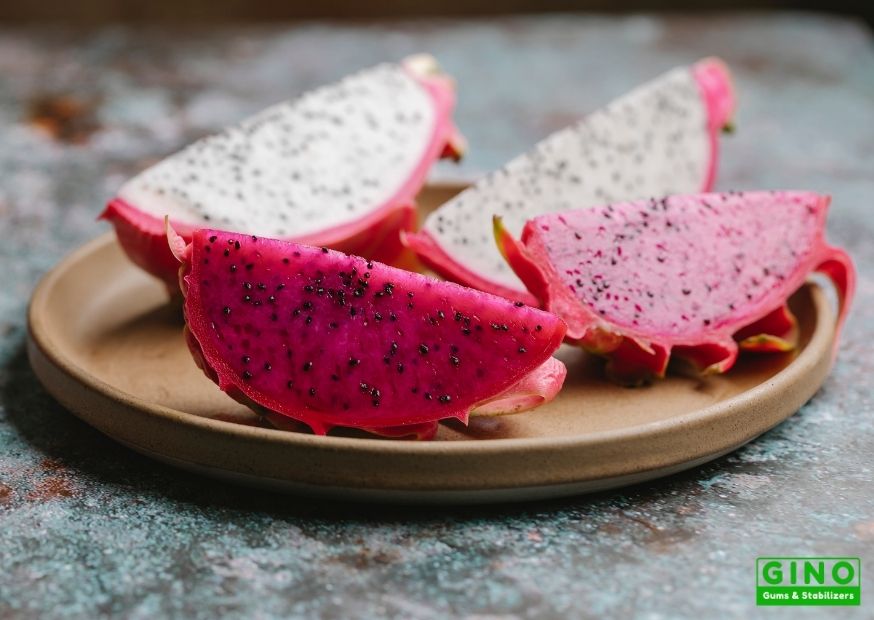
Next, we take dragon fruit as the main raw material and citric acid, sugar, xanthan gum, sodium carboxymethyl cellulose (CMC-Na), and carrageenan as auxiliary ingredients to make a dragon fruit suspension drink.
3.1 Materials
Dragon fruit (red skin and white flesh varieties), sugar, citric acid, xanthan gum, sodium carboxymethyl cellulose (CMC-Na), carrageenan, etc.
3.2 Process Flow
|
|
|
|
| Suspending agents | → | Heat dissolving |
|
| |
|
|
|
|
|
|
|
| ↓ |
|
|
Raw material selection | → | Cleaning | → | Peeling, cutting | → | Pulp making | → | Blending | → | Filling |
|
|
|
|
|
|
|
| ↑ |
| ↓ |
|
| Dragon fruit | → | Pretreatment | → | Cutting | → | Calcification |
| |
|
|
|
|
|
|
|
|
|
| |
|
|
|
|
|
| Final products | ← | Cooling | ← | Pasteurization |
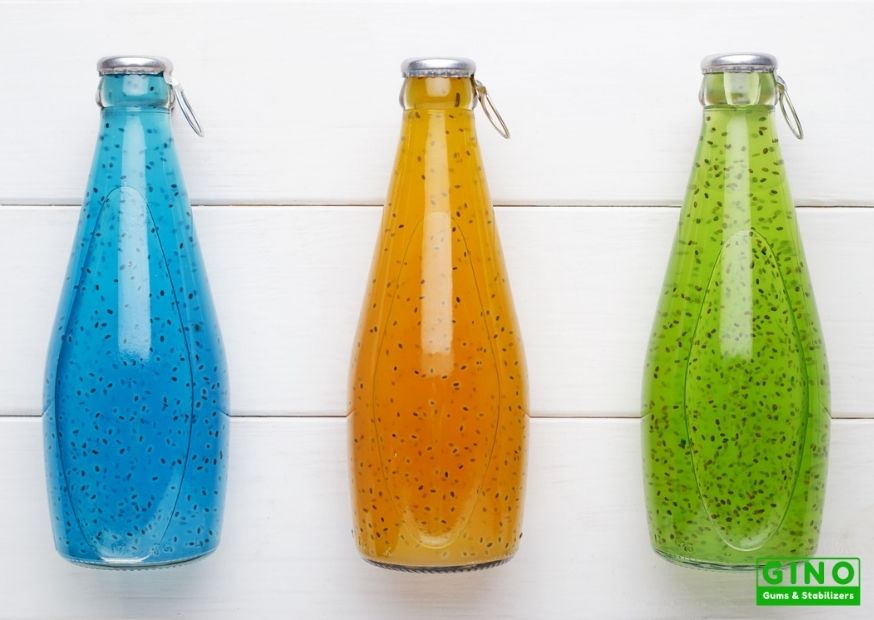
3.3 Operation Points
3.3.1 Raw Material Selection
Select the fruit body surface clean, with no cracks, and no frostbite fresh dragon fruit, and check the degree of hardness and softness of the fruit body, gently press the fruit body with your fingers to remove the soft texture of dragon fruit.
3.3.2 Cleaning, Peeling, Cutting
Place the selected fresh dragon fruit in a stainless steel basin, rinse its surface with running tap water, and remove impurities on the surface of the fruit body.
Then, gently separate the flesh from the peel to remove the skin, so as not to cause damage to the flesh and waste of raw materials. After peeling, check whether the thin pink skin on the surface of the fruit body is removed, if too much thin pink skin remains, it will affect the sensory quality of the finished product. Finally, part of the peeled dragon fruit was cut into pieces, and the other part of the refrigerated spare was.
3.3.3 Preparation of Dragon Fruit Pulp
Put the dragon fruit cut into pieces into the juicer and make pulp. Until the pulp is uniform, with no grains, put it into the container and refrigerate.
3.3.4 Preparation of Dragon Fruit Pellets
The peeled dragon fruit was cut into 4 mm3 pellets and blanched with boiling water for 10-15 s. To prevent a browning reaction before use, the pellets were soaked in 0.1% isoascorbic acid solution for 30 min.
Finally, the pellets were rinsed 3~5 times with purified water and kept in the refrigerator (around 5 ℃).
3.3.5 Preparation of Suspension Stabilizer
Add 0.2% xanthan gum and 0.15% CMC-Na compound suspension stabilizer to the appropriate amount of warm water (about 40 ℃) (about 100 mL), and keep it at 90-95 ℃ for 2-3 min in the water bath, stirring gently with a glass rod to dissolve it.
3.3.6 Preparation of Dragon Fruit Suspension Beverage
Take a certain amount of pure water and add 15% dragon fruit pulp, 6% sugar, and compound suspension stabilizer, heat and make the sugar finish 3.3.7 Filling
Before filling, select and clean the required glass beverage bottles, reject the second bottles, and after cleaning, pour them into a clean plastic basket 3.3.8 Sterilization
Adopt the pasteurization method, put the filled suspended beverage in 85 ℃ warm water, and keep it for 20~25 min, after the sterilization is finished, cool it to room temperature.
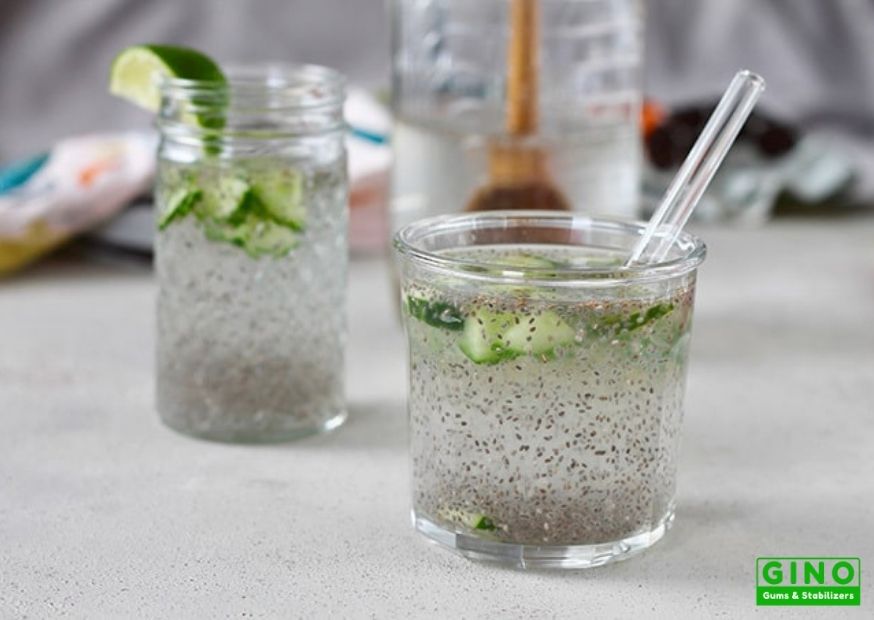
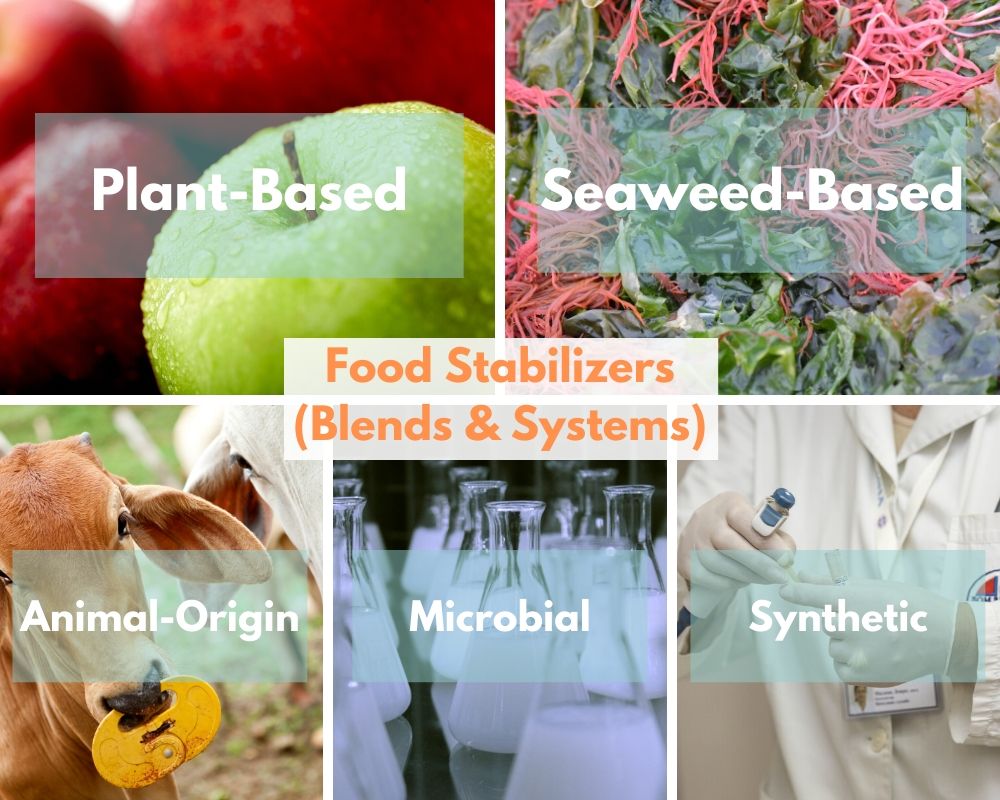
12 Amazing Food Hydrocolloids: Comparison of Properties
Our plant-based meat stabilizers are made of selected natural vegan hydrocolloids and other thickeners and additives.

